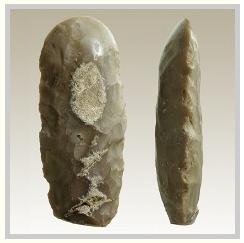A polished axe from the Neolithic period. Credit: Tel Aviv University
TEL AVIV, Israel, Aug. 9 (UPI) -- The transition from hunting to agricultural society in Neolithic times parallels the development of woodworking tools, Israeli researchers say.
"Intensive woodworking and tree-felling was a phenomenon that only appeared with the onset of the major changes in human life, including the transition to agriculture and permanent villages," Ran Barkai of Tel Aviv University said.
Before to the Neolithic period, around 10,000 to 6,000 B.C., there is no evidence of tools that were powerful enough to cut and carve wood, let alone fell trees, he said, but new archaeological evidence suggests that as the Neolithic age progressed, sophisticated carpentry developed alongside agriculture.
"We can document step by step the transition from the absence of woodworking tools, to delicate woodworking tools, to heavier woodworking tools," Barkai said, and this follows the "actual transition from the hunter-gatherer lifestyle to agriculture."
Whether the transition to an agricultural society led to the development of major carpentry tools or vice versa remains to be determined, said Barkai, who calls it a "circular argument."
Beyond the change from a hunter-gatherer to an agricultural economy, a new form of architecture also emerged, as round and oval structures of earlier times were replaced by rectangular structures.
"Evidence tells that us that for each home, approximately 10 wooden beams were needed," Barkai said. "Prior to this, there were no homes with wooden beams."
These architectural developments, along with building pens and fences for domesticated animals, required the felling of trees in large quantities and a growing use of wood, he said.















